Submitted:
10 May 2023
Posted:
10 May 2023
You are already at the latest version
Abstract
Keywords:
1. Introduction
2. Geological Background and Petrography
3. Analytical Methods
3.1. Zircon U-Pb Dating and Hf Isotope Analyses
3.2. Whole-Rock Major and Trace Elements Analyses
3.3. Whole-Rock Sr-Nd Isotope Analyses
4. Results
4.1. Zircon U–Pb Geochronology
4.2. Whole-Rock Major and Trace Elements
4.3. Whole Rock Sr-Nd Isotopes
4.4. Zircon Hf Isotopes
5. Discussion
5.1. Petrogenesis
5.2. Tectonic Implications
6. Conclusions
Author Contributions
Funding
Data Availability Statement
Acknowledgments
Conflicts of Interest
References
- Zhang, J.X.; Yu, S.Y.; Li, Y.S.; Yu, X.X.; Lin, Y.H.; Mao, X.H. Subduction, accretion and closure of Proto-Tethyan Ocean: Early Paleozoic accretion/collision orogeny in the Altun-Qilian-North Qaidam orogenic system. Acta Petrol. Sin. 2015, 31, 3531–3554, (in Chinese with English abstract). [Google Scholar]
- Yu, S.Y.; Peng, Y.B.; Zhang, J.X.; Li, S.Z.; Santosh, M.; Li, Y.S.; Liu, Y.J.; Gao, X.Y.; Ji, W.T.; Lv, P.; Li, C.Z.; Jiang, X.Z.; Qi, L.L.; Xie, W.M.; Xu, L.J. Tectono-thermal evolution of the Qilian orogenic system: Tracing the subduction, accretion and closure of the Proto-Tethys Ocean. Earth Sci. Rev. 2021, 215, 103547. [Google Scholar] [CrossRef]
- Xiao, W.J.; Windley, B.F.; Yong, Y.; Yan, Z.; Yuan, C.; Liu, C.Z.; Li, J.L. Early Paleozoic to Devonian multiple-accretionary model for the Qilian Shan, NW China. J. Asian Earth Sci. 2009, 35, 323–333. [Google Scholar] [CrossRef]
- Xu, Z.Q.; Xu, H.F.; Zhang, J.X.; Li, H.B.; Zhu, Z.Z.; Qu, J.C.; Chen, D.Z.; Chen, J.L.; Yang, K.C. The Zhoulangnanshan Caledonian subductive complex in the Northern Qilian Mountains and its dynamics. Acta Geol. Sin. 1994, 68, 1–15, (in Chinese with English abstract). [Google Scholar]
- Song, S.G; Niu, Y.L.; Su, L.; Xia, X.H. Tectonics of the North Qilian orogen, NW China. Gondwana Res. 2013, 23, 1378–1401. [Google Scholar] [CrossRef]
- Xia, L,Q. ; Li, X.M.; Yu, J.Y.; Wang, G.Q. Mid-Late Neoproterozoic to Early Paleozoic volcanism and tectonic evolution of the Qilian Mountain. China Geology, 2016, 43, 1087–1138, (in Chinese with English abstract). [Google Scholar]
- Wu, C.L.; Xu, X.Y.; Gao, Q.M.; Li, X.M.; LeI, Min. ; Gao, Y.H.; Frost, R.B.; Wooden, J.L. Early Palaezoic granitoid magmatism and tectonic evolution in North Qilian, NW China. Acta Petrol. Sin. 2010, 26, 1027–1044, (in Chinese with English abstract). [Google Scholar]
- Wang, C.Y.; Zhang, Q.; Qian, Q.; Zhou, M.F. Geochemistry of the Early Paleozoic Baiyin Volcanic Rocks (NW China): Implications for the Tectonic Evolution of the North Qilian Orogenic Belt. J. Geol. 2005, 113, 83–94. [Google Scholar] [CrossRef]
- Xia, L.Q.; Li, X.M.; Yu, J.Y.; Wang, G.Q. Mid-late neoproterozoic to early paleozoic volcanism and tectonic evolution of the Qilianshan, NW China. GeoResJ, 2016; 9-12, 1–41. [Google Scholar]
- Tseng, C.Y.; Yang, H.J.; Yang, H.Y.; Liu, D.Y.; Wu, C.L.; Cheng, C.K.; Chen, C.H.; Ker, C.M. Continuity of the North Qilian and North Qinling orogenic belts, Central Orogenic System of China: Evidence from newly discovered Paleozoic adakitic rocks. Gondwana Res. 2009, 16, 285–293. [Google Scholar] [CrossRef]
- Yu, S.Y.; Zhang, J.X.; Qin, H.P.; Sun, D.Y.; Zhao, X.L.; Cong, F.; Li, Y.S. Petrogenesis of the early Paleozoic low-Mg and high-Mg adakitic rocks in the North Qilian orogenic belt, NW China: Implications for transition from crustal thickening to extension thinning. J. Asian Earth Sci. 2015, 107, 122–139. [Google Scholar] [CrossRef]
- Chen, S.; Niu, Y.L.; Sun, W.L.; Zhang, Y.; Li, J.Y.; Guo, P.Y.; Sun, P. On the origin of mafic magmatic enclaves (MMEs) in syn-collisional granitoids: evidence from the Baojishan pluton in the North Qilian Orogen, China. Miner Petrol, 2015, 109, 577–596. [Google Scholar] [CrossRef]
- Chen, S.; Niu, Y.L.; Li, J.Y.; Sun, W.L.; Zhang, Y.; Hu, Y.; Shao, F.L. Syn-collisional adakitic granodiorites formed by fractional crystallization: Insights from their enclosed mafic magmatic enclaves (MMEs) in the Qumushan pluton, North Qilian Orogen at the northern margin of the Tibetan Plateau. Lithos 2016, 248-251, 455–468. [Google Scholar] [CrossRef]
- Yang, H.; Zhang, H.F.; Xiao, W.J.; Zhang, J.; Xiong, Z.L.; Guo, L.; Pan, F.B. Petrogenesis of Early Paleozoic high Sr/Y intrusive rocks from the North Qilian orogen: Implication for diachronous continental collision. Lithosphere, 2019, 12, 53–73. [Google Scholar] [CrossRef]
- Tarney, J.; Jones, C.E. Trace element geochemistry of orogenic igneous rocks and crustal growth models. J. Geol. Soc. 1994, 151, 855–868. [Google Scholar] [CrossRef]
- Fowler, M.B.; Henney, P.J.; Darbyshire, D.P.F.; Greenwood, P.B. Petrogenesis of high Ba-Sr granites; the Rogart Pluton, Sutherland. J. Geol. Soc. 2001, 158, 521–534. [Google Scholar] [CrossRef]
- Qian, Q.; Chung, S.L.; Lee, T.Y.; Wen, D.J. Mesozoic high-Ba-Sr granitoids from North China: geochemical characteristics and geological implications. Terra Nova, 2003, 15, 272–278. [Google Scholar] [CrossRef]
- Wang, Z.L.; Zhao, R.X.; Zhang, Q.; Lu, H.W.; Li, J.L.; Cheng, W. Magma mixing for the high Ba-Sr Guojialing-type granitoids in Northwest Jiaodong Peninsula: Constraints from petrogeochemistry and Sr-Nd isotopes. Acta Petrol. Sin. 2014, 30, 2595–2608, (in Chinese with English abstract). [Google Scholar]
- Choi, S.G.; Rajesh, V.J.; Seo, J.; Park, J.W.; Oh, C.W.; Pak, S.J.; Kim, S.W. Petrology, geochronology and tectonic implications of Mesozoic high Ba-Sr granites in the Haemi area, Hongseong Belt, South Korea. Island Arc, 2009, 18, 266–281. [Google Scholar] [CrossRef]
- Fowler, M.B.; Kocks, H.; Darbyshire, D.P.F.; Greenwood, P.B. Petrogenesis of high Ba–Sr plutons from the Northern Highlands Terrane of the British Caledonian Province. Lithos, 2008, 105, 129–148. [Google Scholar] [CrossRef]
- Peng, T.P.; Wilde, S.A.; Fan, W.M.; Peng, B.X. Late Neoarchean potassic high Ba–Sr granites in the Taishan granite–greenstone terrane: Petrogenesis and implications for continental crustal evolution. Chem. Geol. 2013, 344, 23–41. [Google Scholar] [CrossRef]
- Ren, L.; Liang, H.Y.; Bao, Z.W.; Zhang, J.; Li, K.X.; Huang, W.T. The petrogenesis of early Paleozoic high-Ba–Sr intrusions in the North Qinling terrane, China, and tectonic implications. Lithos 2018, 314-315, 534–550. [Google Scholar] [CrossRef]
- Zhang, L.Q.; Zhang, H.F.; Hawkesworth, C.; Luo, B.J.; Yang, H.; Xu, W.C.; Guo, L.; Pan, F.B.; Gao, Z.; Tao, L. Sediment contribution in post-collisional high Ba-Sr magmatism: Evidence from the Xijing pluton in the Alxa block, NW China. Gondwana Res. 2019, 69, 177–192. [Google Scholar] [CrossRef]
- Wang, Y.F.; Shao, Y.; Jiang, S.Y.; Zhang, Z.Z.; Hu, J.; Xiao, E.; Dai, B.Z.; Li, H.Y. Petrogenesis of Indosinian High Ba-Sr Granites in Laoniushan Batholith, Shaanxi Province and Their Tectonic Implications. Geo. J. China Univ. 2012, 18, 133–149, (in Chinese with English abstract). [Google Scholar]
- Ye, H.M.; Li, X.H.; Li, Z.X.; Zhang, C.L. ; Age and origin of high Ba–Sr appinite–granites at the northwestern margin of the Tibet Plateau: Implications for early Paleozoic tectonic evolution of the Western Kunlun orogenic belt. Gondwana Res. 2008, 13, 126–138. [Google Scholar] [CrossRef]
- Zhang, Y.Y.; Sun, M.; Yuan, C.; Xu, Y.G.; Long, X.P. ; Magma mixing origin for high Ba–Sr granitic pluton in the Bayankhongor area, central Mongolia: Response to slab roll-back. J. Asian Earth Sci. 2015, 113, 353–368. [Google Scholar] [CrossRef]
- Song, S.G.; Wu, Z.Z.; Yang, L.M.; Su, L.; Xia, X.H.; Wang, C.; Dong, J.L.; Zhou, C.A.; Bi, H.Z. Ophiolite belts and evolution of the Proto-Tethys Ocean in the Qilian Orogen. Acta Petrol. Sin. 2019, 35, 2948–2970, (in Chinese with English abstract). [Google Scholar]
- Qian, Q.; Zhang, Q.; Sun, X.M.; Wang, Y.M. Geochemical features and tectonic setting for basalts and cherts from Laohushan, North Qilian. Sci Geol. Sin. 2001, 36, 444–453, (in Chinese with English abstract). [Google Scholar]
- Fu, D.; Huang, B.; Johnson, T.E.; Wilde, S.A.; Jourdan, F.; Polat, A.; Windley, B.F.; Hu, Z.C.; Kusky, T. Boninitic blueschists record subduction initiation and subsequent accretion of an arc–forearc in the northeast Proto-Tethys Ocean. Geology, 2022, 50, 10–15. [Google Scholar] [CrossRef]
- Zhang, J.X.; Meng, F.C.; Wan, Y.S. A cold early Palaeozoic subduction zone in the North Qilian Mountains, NW China: petrological and U-Pb geochronological constraints. J. Meta Geol. 2007, 25, 285–304. [Google Scholar] [CrossRef]
- Song, S.G.; Niu, Y.L.; Zhang, L.F.; Wei, C.J.; Liou, J.G.; Su, L. Tectonic evolution of early Paleozoic HP metamorphic rocks in the North Qilian Mountains, NW China: New perspectives. J. Asian Earth Sci. 2009, 35, 334–353. [Google Scholar] [CrossRef]
- Wu, C.L.; Gao, Y.H.; Frost, B.R.; Robison, P.T.; Wooden, J.L.; Wu, S.P.; Chen, Q.L.; Lei, M. An early Palaeozoic double-subduction model for the North Qilian oceanic plate: evidence from zircon SHRIMP dating of granites. Int. Geol. Rev. 2011, 53, 157–181. [Google Scholar] [CrossRef]
- Wang, J.R.; Wu, C.J.; Cai, Z.H.; Guo, Y.S.; Wu, J.C.; Liu, X.H. Early Paleozoic high-Mg adakite from Yindongliang in the eastern section of the North Qilian: Implications for geodynamics and Cu-Au mineralization. Acta Petrol. Sin. 2006, 22, 2655–2664, (in Chinese with English abstract). [Google Scholar]
- Hu, Z.C.; Zhang, W.; Liu, Y.S.; Gao, S.; Li, M.; Zong, K.Q.; Chen, H.H.; Hu, S.H. “Wave” signal-smoothing and mercury-removing device for laser ablation quadrupole and multiple collector ICPMS analysis: application to lead isotope analysis. Anal. Chem. 2015, 87, 1152–1157. [Google Scholar] [CrossRef] [PubMed]
- Zong, K.Q.; Klemd, R.; Yuan, Y.; He, Z.Y.; Guo, J.L.; Shi, X.L.; Liu, Y.S.; Hu, Z.C.; Zhang, Z.M. The assembly of Rodinia: The correlation of early Neoproterozoic (ca. 900 Ma) high-grade metamorphism and continental arc formation in the southern Beishan Orogen, southern Central Asian Orogenic Belt (CAOB). Precambrian Res. 2017, 290, 32–48. [Google Scholar] [CrossRef]
- Liu, Y.S.; Gao, S.; Hu, Z.C.; Gao, C.G.; Zong, K.Q.; Wang, D.B. Continental and Oceanic Crust Recycling-induced Melt-peridotite Interactions in the Trans-North China Orogen: U-Pb Dating, Hf Isotopes and Trace Elements in Zircons of Mantle Xenoliths. J. Petrol. 2010, 51, 537–571. [Google Scholar] [CrossRef]
- Ludwig, K.R. User’s Manual for Isoplot/ex Version 3.00: A Geochronological Toolkit for Microsoft Excel; Special Publication; Berkeley Geochronology Center: Berkeley, CA, USA, 2003. [Google Scholar]
- Hu, Z.C.; Liu, Y.S.; Gao, S.; Liu, W.G.; Zhang, W.; Tong, X.R.; Lin, L.; Zong, K.Q.; Li, M.; Chen, H.H.; Zhou, L.; Yang, L. Improved in situ Hf isotope ratio analysis of zircon using newly designed X skimmer cone and Jet sample cone in combination with the addition of nitrogen by laser ablation multiple collector ICP-MS. J. Anal. At. Spectrom. 2012, 27, 1391–1399. [Google Scholar] [CrossRef]
- Zhang, W.; Hu, Z.C.; Spectroscopy, A. Estimation of Isotopic Reference Values for Pure Materials and Geological Reference Materials. Atom. Spectrosc. 2020, 41, 93–102. [Google Scholar] [CrossRef]
- Griffin, W.L.; Belousova, E.A.; Shee, S.R.; Pearson, N.J.; O’Reilly, S.Y. Archean Crustal Evolution in the Northern Yilgarn Craton: U-Pb and Hf-isotope Evidence from Detrital Zircons. Precambrian Res. 2004, 131, 231–282. [Google Scholar] [CrossRef]
- Paul, W. O. H; Urs, S. The Composition of Zircon and Igneous and Metamorphic Petrogenesis. Rev. Mineral. Geochem. 2003, 53, 27–62. [Google Scholar]
- Kelemen, P.B.; Hanghøj, K.; Greene, A.R. One View of the Geochemistry of Subduction-Related Magmatic Arcs, with an Emphasis on Primitive Andesite and Lower Crust. Treatise. Geochem. 2003, 3, 593–659. [Google Scholar]
- Yang, L.Q.; Dilek, Y.; Wang, Z.L.; Weinberg, R.F.; Liu, Y. Late Jurassic, high Ba–Sr Linglong granites in the Jiaodong Peninsula, East China: lower crustal melting products in the eastern North China Craton. Geol. Mag. 2018, 155, 1040–1062. [Google Scholar] [CrossRef]
- Beard, J.S.; Lofgren, G.E. Dehydration Melting and Water-Saturated Melting of Basaltic and Andesitic Greenstones and Amphibolites at 1, 3, and 6.9 kb. J. Petrol. 1991, 32, 365–401. [Google Scholar] [CrossRef]
- Qian, Q.; Zhang, Q. Geochemical characteristics and tectonic setting of the Laohushan Basalts, north Qilian Mountains. Acta Geol. Sin. 2001, 75, 452–457. [Google Scholar]
- Hou, Q.Y.; Zhao, Z.D.; Zhang, B.R.; Zhang, H.F.; Zhang, L.; Chen, Y.L. On the boundary of Tethyan tectonic domain on northeastern margin of the Tibetan Plateau. Acta Petrol. Sin. 2006, 22, 567–577, (in Chinese with English abstract). [Google Scholar] [CrossRef]
- Chen, Y.X.; Xia, X.H.; Song, S.G. Petrogenesis of Aoyougou high-silica adakite in the North Qilian orogen, NW China: Evidence for decompression melting of oceanic slab. Chin. Sci. Bull. 2012, 57, 2072–2085, (in Chinese with English abstract). [Google Scholar] [CrossRef]
- Martin, H.; Smithies, R.H.; Rapp, R.; Moyen, J.F.; Champion, D. An overview of adakite, tonalite–trondhjemite–granodiorite (TTG), and sanukitoid: relationships and some implications for crustal evolution. Lithos, 2005, 79, 1–24. [Google Scholar] [CrossRef]
- Qian, Q.; Hermann, J. Partial melting of lower crust at 10–15 kbar: constraints on adakite and TTG formation. Contrib. Mineral. Petrol. 2013, 165, 1195–1224. [Google Scholar] [CrossRef]
- Vigouroux, N.; Wallace, P.J.; Kent, A.J.R. Volatiles in High-K Magmas from the Western Trans-Mexican Volcanic Belt: evidence for Fluid Fluxing and Extreme Enrichment of the Mantle Wedge by Subduction Processes. J. Petrol. 2008, 49, 1589–1618. [Google Scholar] [CrossRef]
- Hermann, j.; Rubatto, D. Accessory phase control on the trace element signature of sediment melts in subduction zones. Chem. Geol. 2009, 265, 512–526. [Google Scholar] [CrossRef]
- Sun, S.S.; McDonough, W.F. Chemical and isotopic systematics of oceanic basalts:implications for mantle composition and processes. In Magmatism in the Ocean Basins; Saunders, A.D., Norry, M.J., Eds.; Special Publications; Geological Society: London, UK, 1989, 42, 313–345. [Google Scholar] [CrossRef]
- Vervoort, J.D.; Patchett, P.J.; Blichert-Toft, J.; Albarède, F. Relationships between Lu-Hf and Sm-Nd Isotopic Systems in the Global Sedimentary System. Earth Planet. Sci. Lett. 1999, 168, 79–99. [Google Scholar] [CrossRef]
- Hoffmann, J.E. , Münker, C., Polat, A. Rosing, M.T.; Schulz, T. The Origin of Decoupled Hf-Nd Isotope Compositions in Eo-archean Rocks from Southern West Greenland. Geochim. Cosmochim. Acta. 2011, 75, 6610–6628. [Google Scholar] [CrossRef]
- Tan, J.; Wei, J.H.; Zhao, S.Q.; Li, Y.J.; Liu, Y.; Liu, X.Y.; Zhang, F.; Ga, J.R.; Wang, Z.H. Petrogenesis of Late Triassic high-Mg diorites and associated granitoids with implications for Paleo-Tethys evolution in the northeast Tibetan Plateau. Geol. Soc. Am. Bull. 2019, 132, 955–976. [Google Scholar] [CrossRef]
- Zhao, S.Q.; Fu, L.B.; Wei, J.H.; Tan, J.; Wang, X.C.; Zhao, Z.X.; Li, X. Petrogenesis and Geodynamic Setting of Late Triassic Quartz Diorites in Zhiduo Area, Qinghai Province. Earth Sci. 2015, 23, 185–220, (in Chinese with English abstract). [Google Scholar]
- Tao, L.; Zhang, H.F.; Gao, Z.; Yang, H.; Zhang, L.Q.; Guo, L.; Pan, F.B. Across-arc geochemical and Sr–Nd–Hf isotopic variations of mafic intrusive rocks at the southern Central Qilian block, China. Gondwana Res. 2018, 59, 108–125. [Google Scholar] [CrossRef]
- Wang, K.X.; Yu, C.D.; Yan, J.; Liu, X.D.; Liu, W.H.; Pan, J.Y. Petrogenesis of Early Silurian granitoids in the Longshoushan area and their implications for the extensional environment of the North Qilian Orogenic Belt, China. Lithos 2019, 342-343, 152–174. [Google Scholar] [CrossRef]
- Fu, D.; Kusky, T.; Wilde, S.A.; Polat, A.; Huang, B.; Zhou, Z.P. Early Paleozoic collision-related magmatism in the eastern North Qilian orogen, northern Tibet: A linkage between accretionary and collisional orogenesis. Geol. Soc. Am. Bull. 2018, 131, 1031–1056. [Google Scholar] [CrossRef]
- Chen, S.; Niu, Y.L.; Xue, Q.Q. Syn-collisional felsic magmatism and continental crust growth: A case study from the North Qilian Orogenic Belt at the northern margin of the Tibetan Plateau. Lithos 2018, 308-309, 53–64. [Google Scholar] [CrossRef]
- Langmuir, C.H.; Vocke, R.D.; Hanson, G.N.; Hart, S.R. A general mixing equation with applications to Icelandic basalts. Earth Planet. Sci. Lett. 1978, 37, 380–392. [Google Scholar] [CrossRef]
- Lee, C-T. A.; Bachmann, O. How important is the role of crystal fractionation in making intermediate magmas? Insights from Zr and P systematics. Earth Planet. Sci. Lett. 2014, 393, 266–274. [Google Scholar] [CrossRef]
- Schiano, P.; Monzier, M.; Eissen, J.P.; Martin, H.; Koga, K.T. Simple mixing as the major control of the evolution of volcanic suites in the Ecuadorian Andes. Contrib. Mineral. Petrol. 2010, 160, 297–312. [Google Scholar] [CrossRef]
- Peng, Y.B.; Yu, S.Y.; Zhang, J.X.; Li, S.Z.; Tong, L.X.; Sun, D.Y. Early Paleozoic arc magmatism and metamorphism in the northern Qilian Block, western China: Petrological and geochronological constraints. Geol. J. 2017, 52, 339–364. [Google Scholar] [CrossRef]
- Zhang, J.X.; Li, J.P.; Yu, S.Y.; Meng, F.C.; Mattinson, C.G.; Yang, H.J.; Ker, C.M. Provenance of eclogitic metasediments in the north Qilian HP/LT metamorphic terrane, western China; geodynamic implications for early Paleozoic subduction-erosion. Tectonophysics 2012, 570-571, 78–101. [Google Scholar] [CrossRef]
- Wilson, M. Igneous petrogenesis; Unwim Hyman: London, UK, 1989; pp. 1–366. [Google Scholar]
- Rollinson, H.R. Using Geochemical Data: Evaluation, Presentation, Interpretation; Longman Group UK Ltd: New York, 1993; pp. 1–352. [Google Scholar]
- Frost, B.R.; Barnes, C.G.; Collins, W.J.; Arculus, R.J. A geochemical classification for granitic rocks. J. Petrol. 2001, 42, 2033–2048. [Google Scholar] [CrossRef]
- Maniar, P.D.; Piccoli, P.M. Tectonic Discrimination of Granitoids. Geol. Soc. Am. Bull. 1989, 101, 635–643. [Google Scholar] [CrossRef]
- Yang, H.; Zhang, H.F.; Luo, B.J; Zhang, J.; Xiong, Z.L.; Guo, L.; Pan, F.B. Early Paleozoic intrusive rocks from the eastern Qilian orogen, NE Tibetan Plateau: Petrogenesis and tectonic significance. Lithos 2015, 224-225, 13–31. [Google Scholar] [CrossRef]
- Vervoort, J.D.; Plank, T.; Prytulak, J. The Hf–Nd isotopic composition of marine sediments. Cosmochim. Acta. 2011, 75, 5903–5926. [Google Scholar] [CrossRef]
- Li, Y.S.; Xu, L.J.; Yu, S.Y.; Zhang, J.X.; Guo, J.; Peng, Y.B.; Zhou, G.S. Partial melting of thickened lower crust in post-collisional setting: Evidence from high silicon adakitic granites in the North Qilian orogen. Geol. J. 2020, 55, 3990–4007. [Google Scholar] [CrossRef]
- Wang, C.; Li, R.S.; Smithies, R.H.; Li, M.; Peng, Y.; Chen, F.N.; He, S.P. Early Paleozoic felsic magmatic evolution of the western Central Qilian belt, Northwestern China, and constraints on convergent margin processes. Gondwana Res. 2017, 41, 301–324. [Google Scholar] [CrossRef]
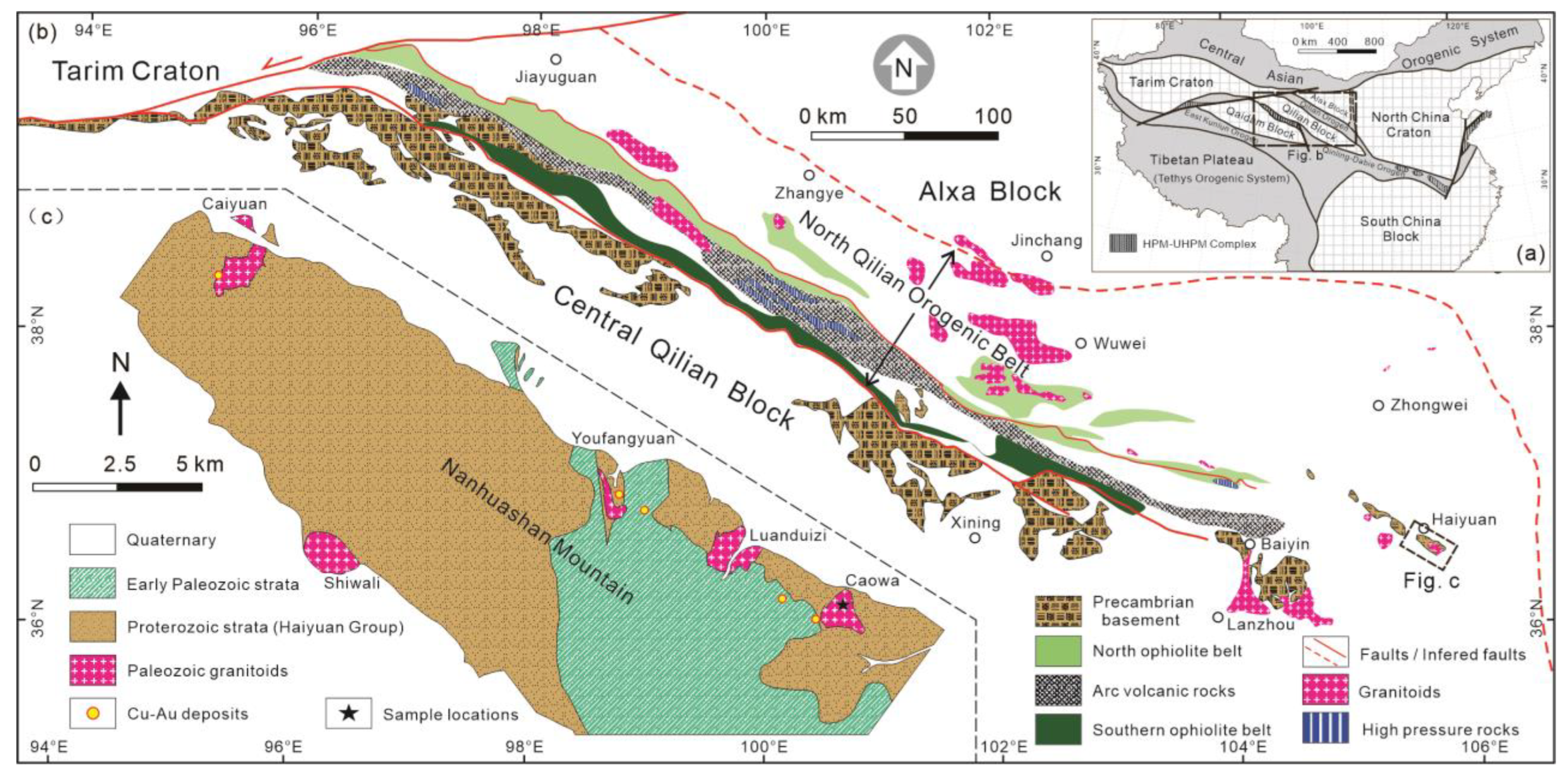
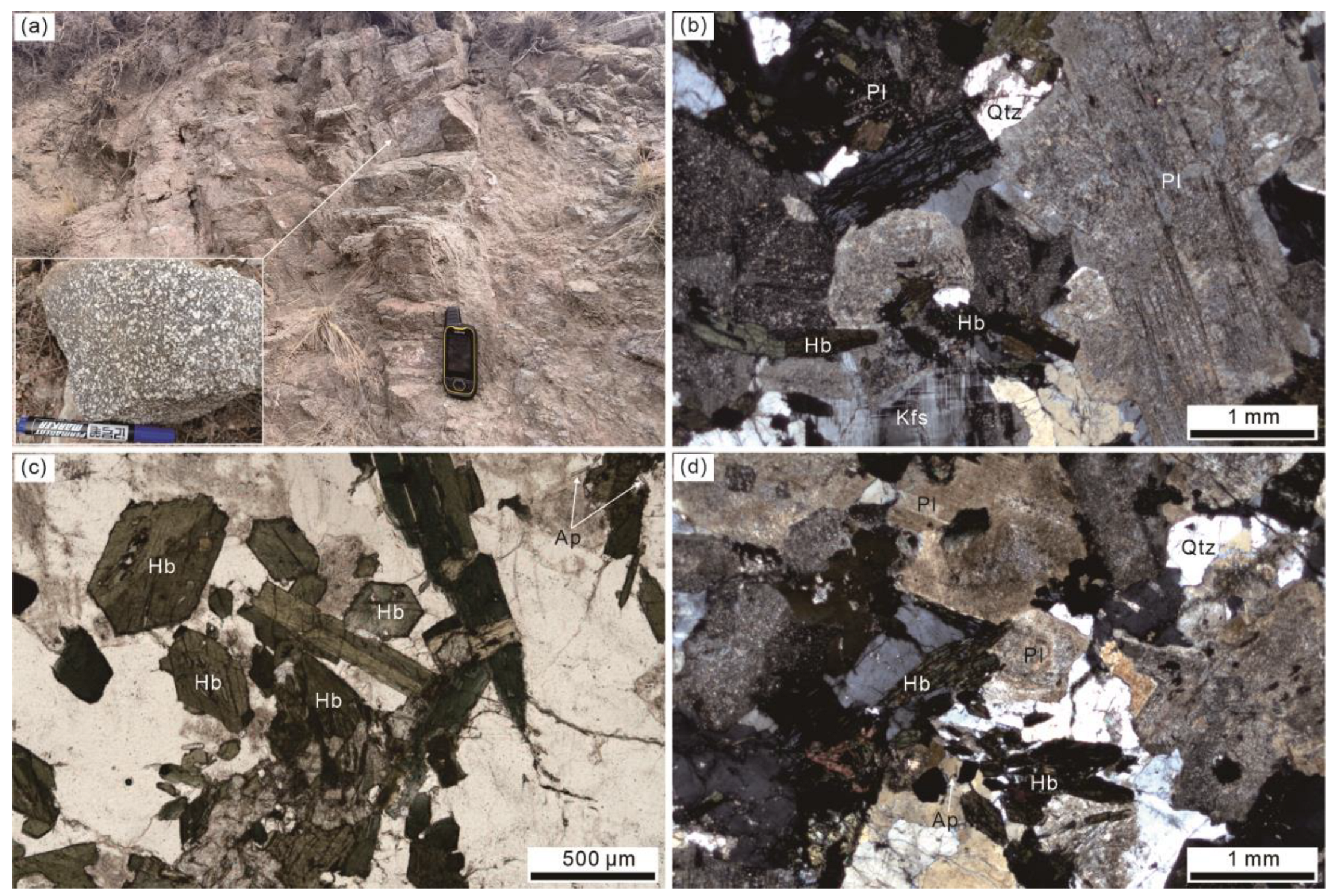
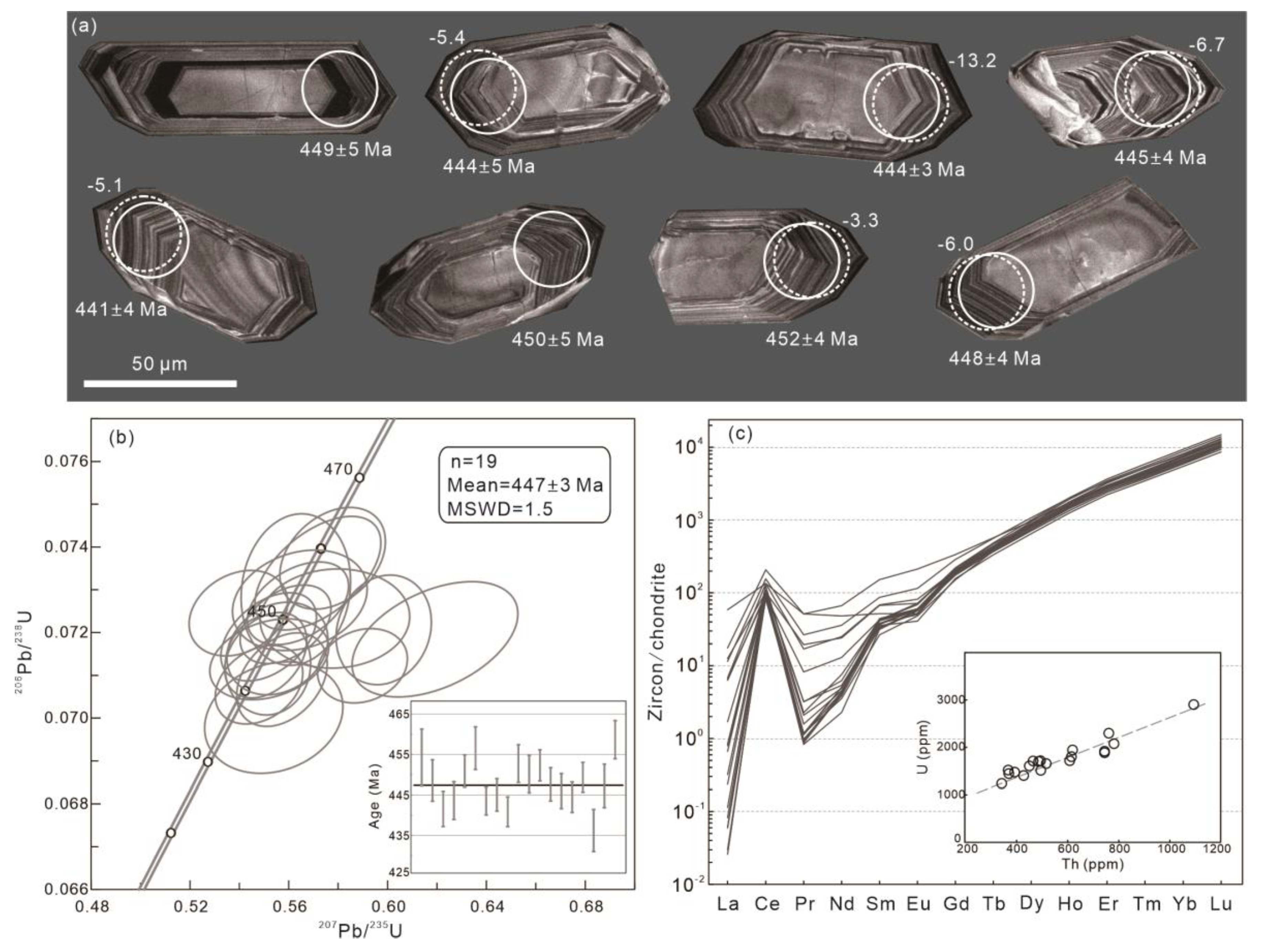
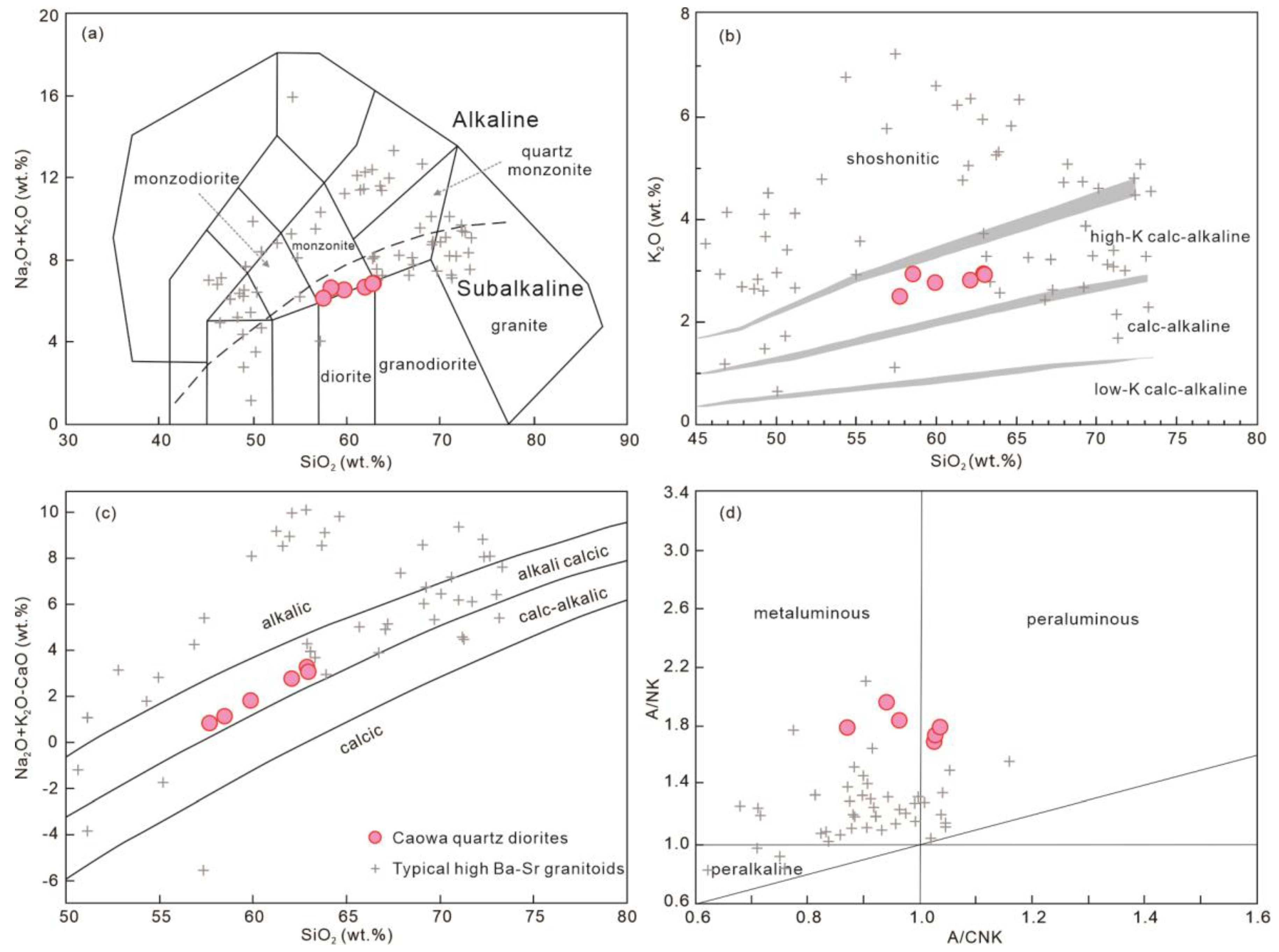
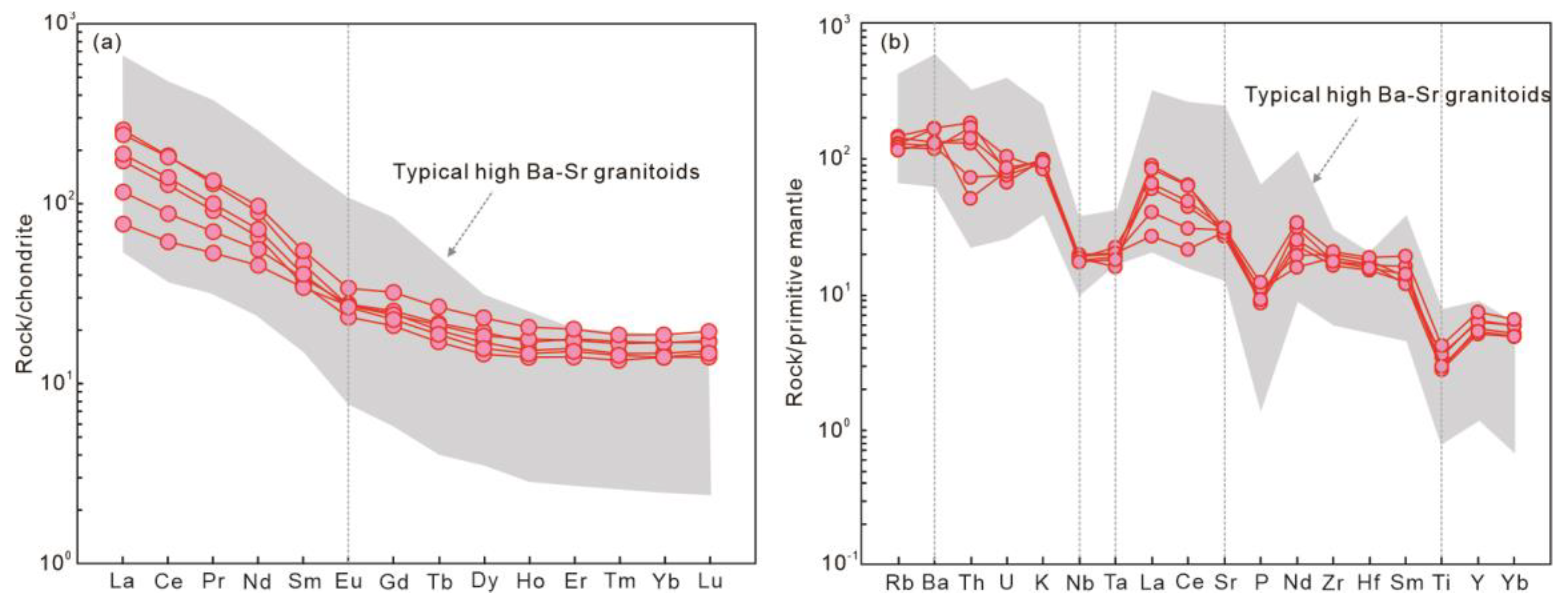
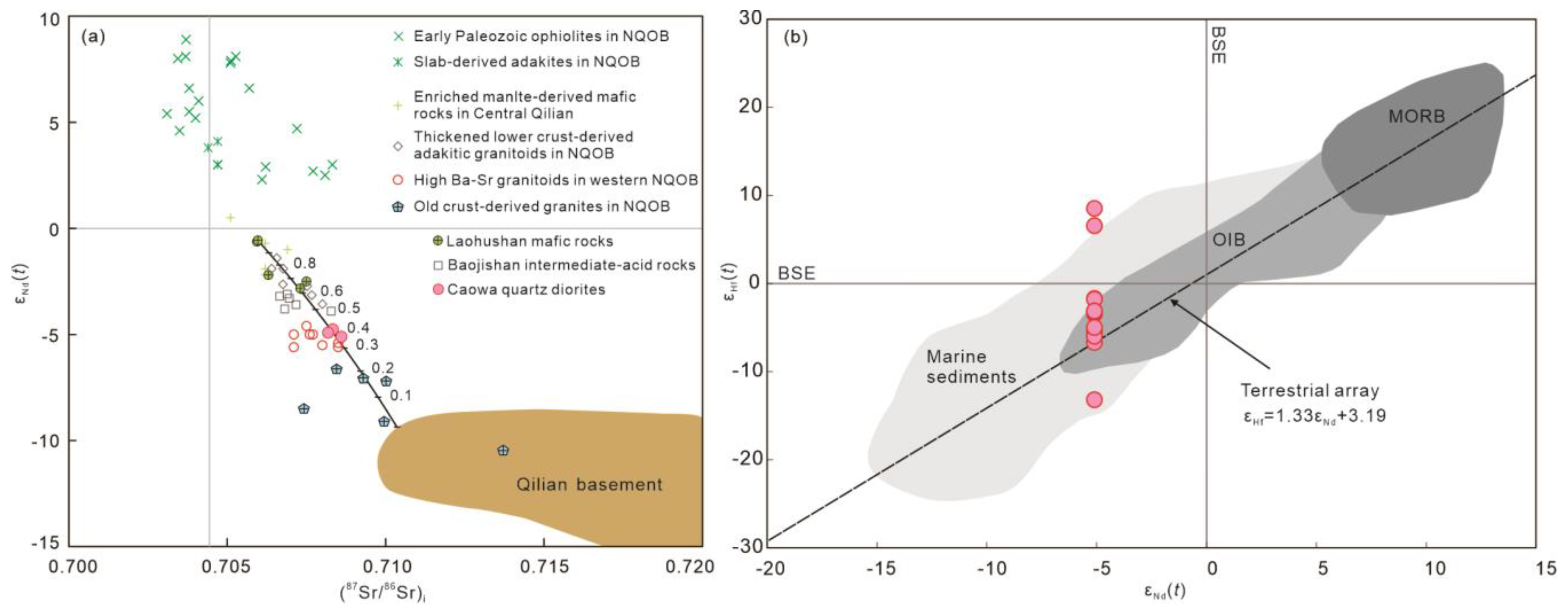
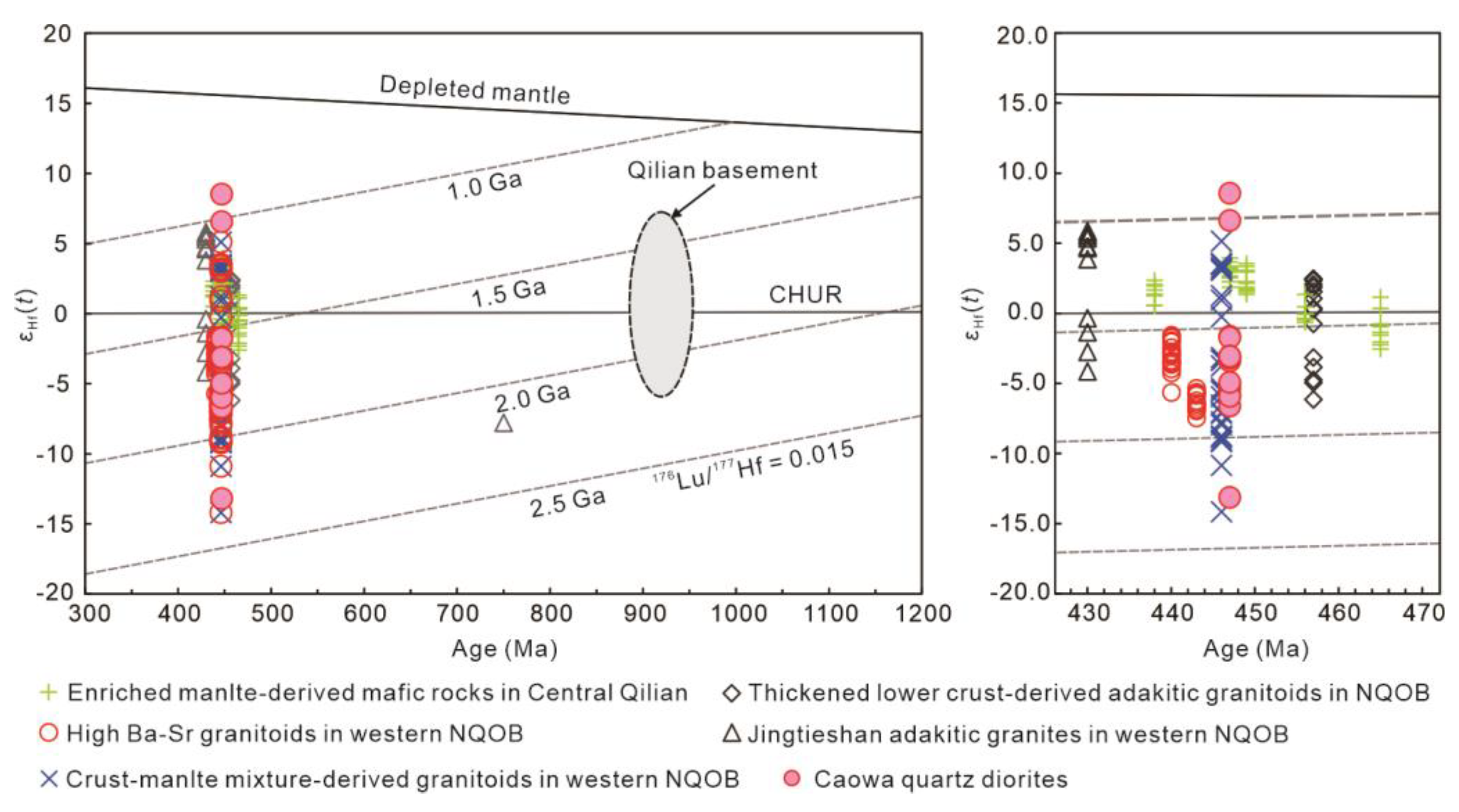
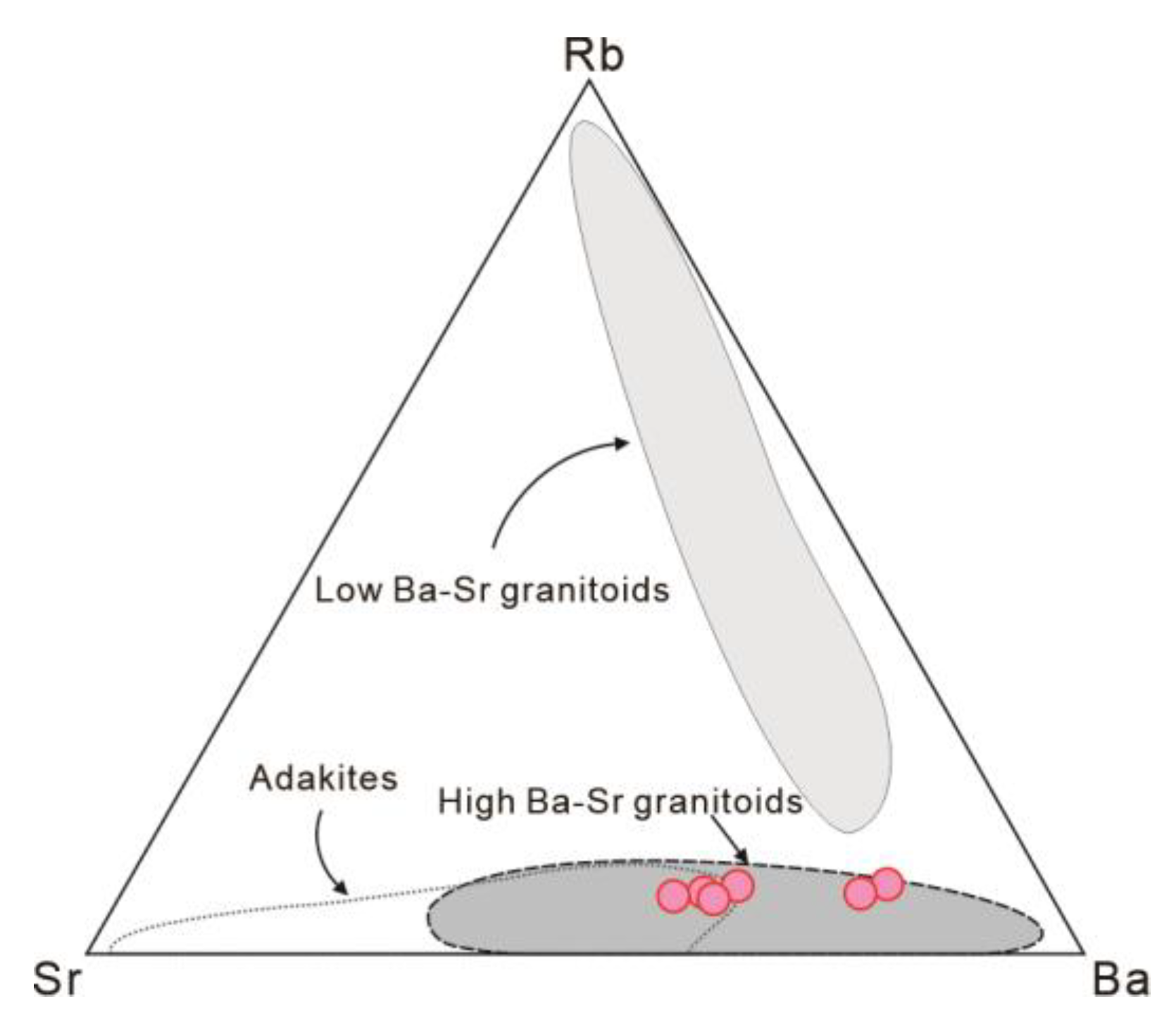
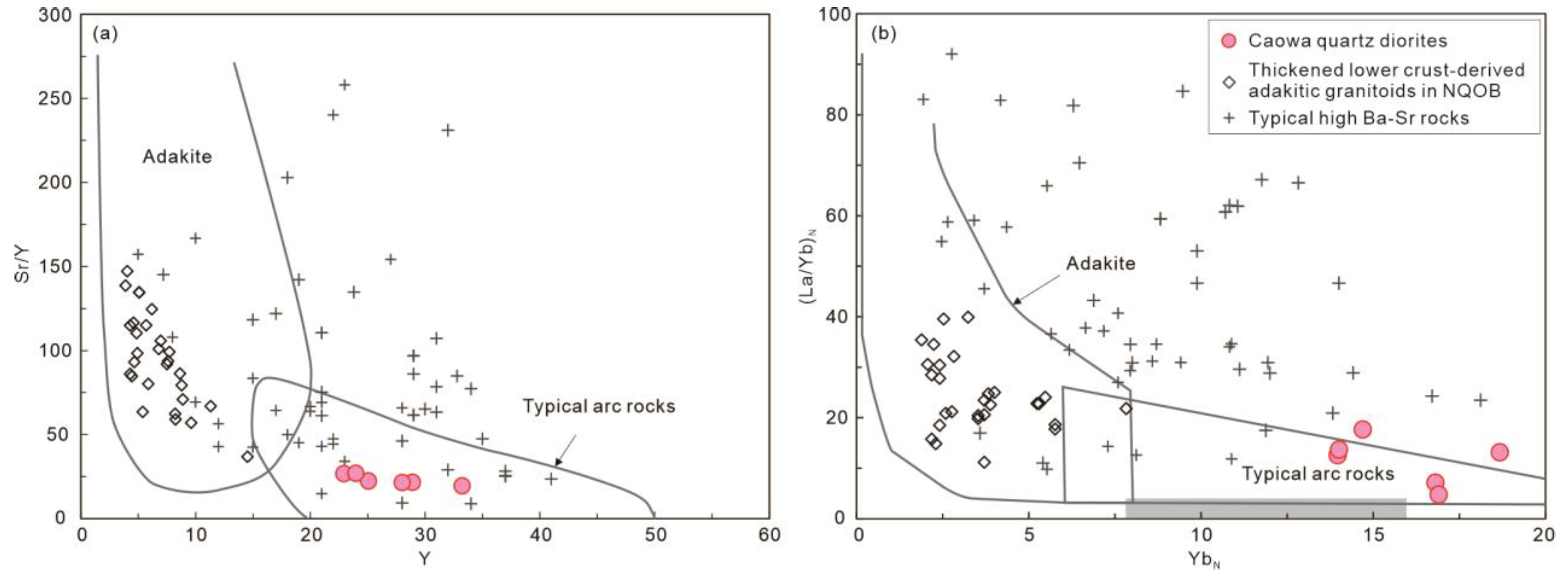
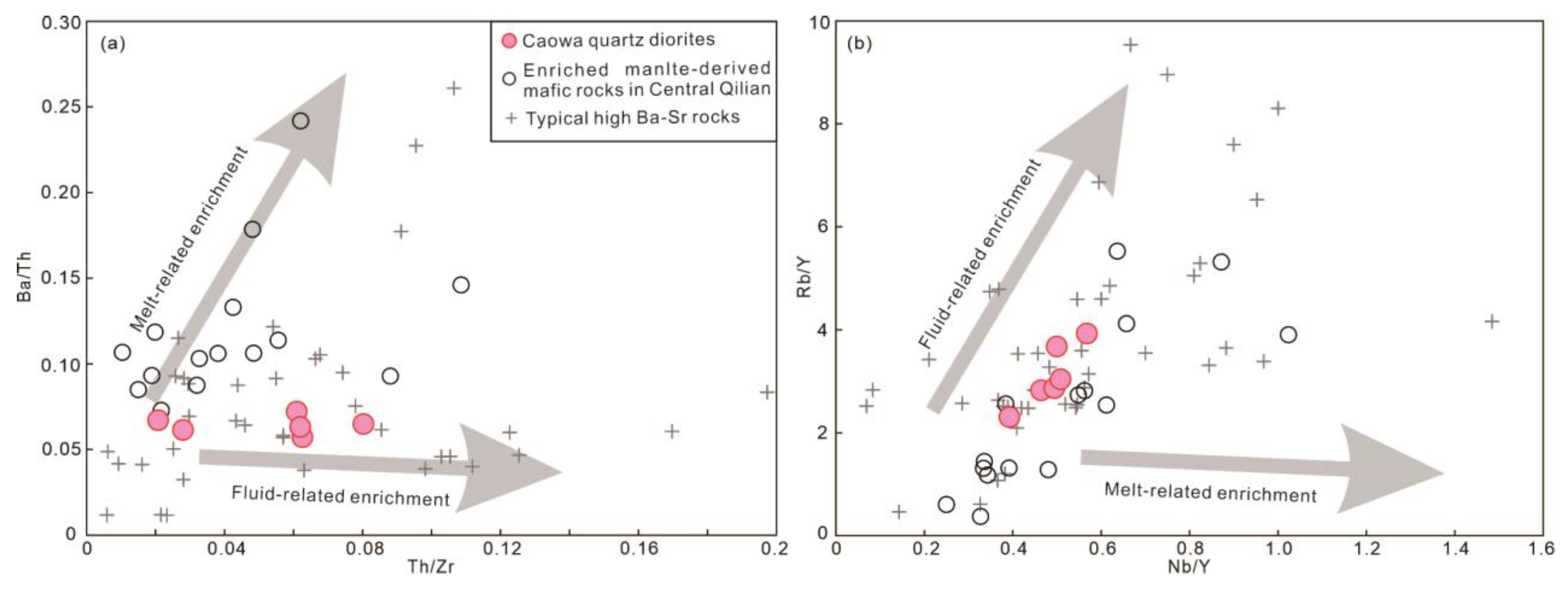
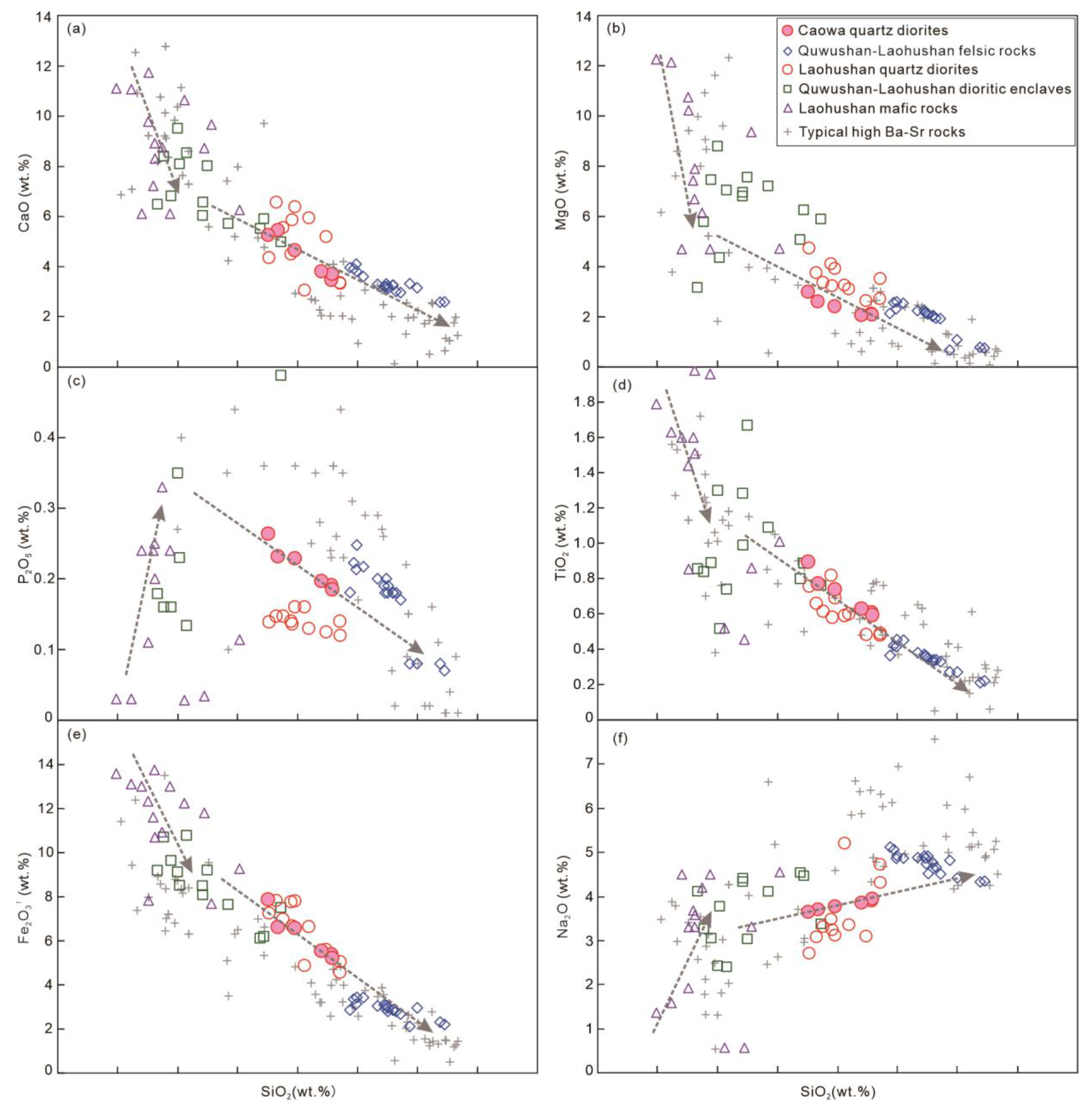
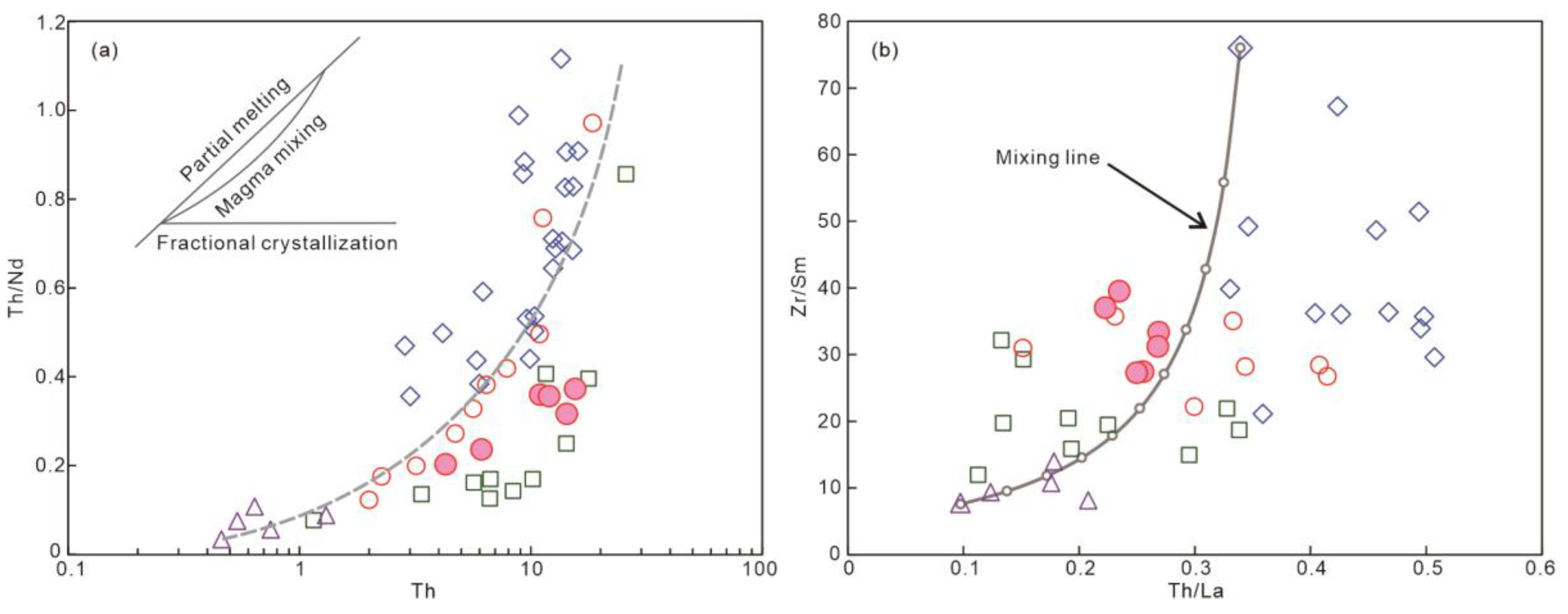
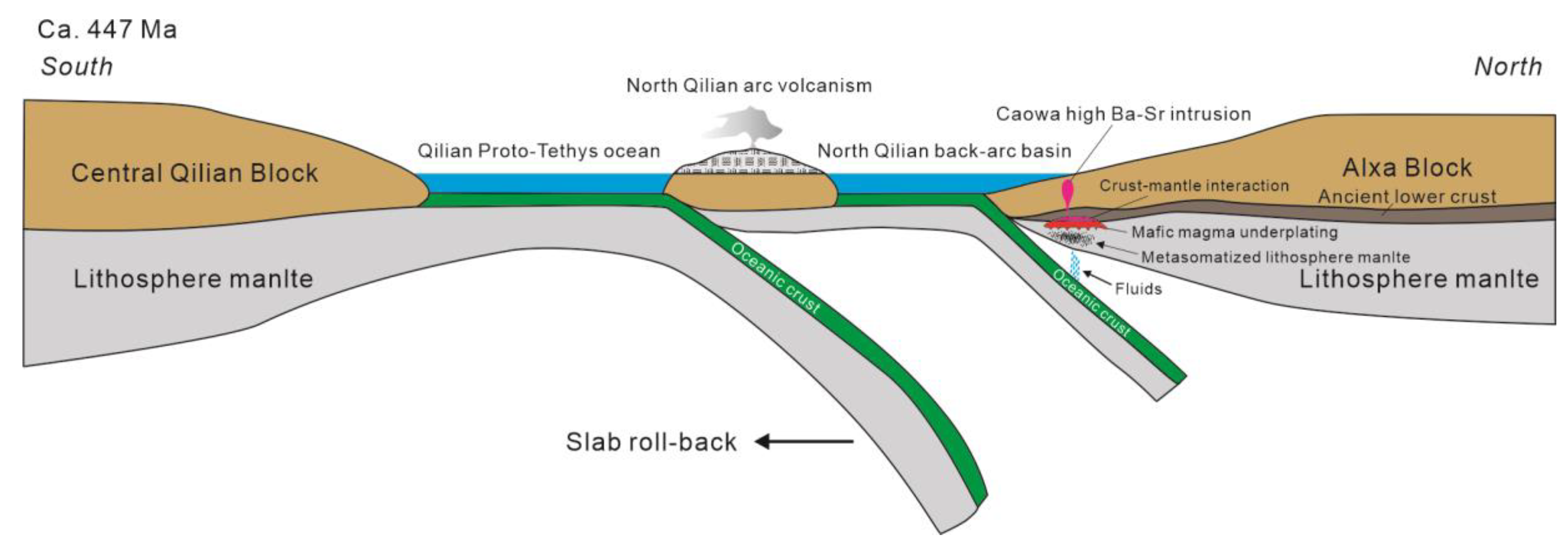
| Spot No. | Contents (ppm) | Th/U | Isotopic Ratios | Isotopic Ages (Ma) | |||||||||||||
| 232Th | 238U | 207Pb/206Pb | 1σ | 207Pb/235U | 1σ | 206Pb/238U | 1σ | 208Pb/232Th | 1σ | 207Pb/206Pb | 1σ | 207Pb/235U | 1σ | 206Pb/238U | 1σ | ||
| CW-6-01 | 744 | 1889 | 0.39 | 0.0546 | 0.0018 | 0.5629 | 0.0146 | 0.0730 | 0.0012 | 0.0224 | 0.0005 | 394 | 79 | 453 | 10 | 454 | 7 |
| CW-6-02 | 1093 | 2859 | 0.38 | 0.0602 | 0.0013 | 0.5984 | 0.0127 | 0.0721 | 0.0008 | 0.0247 | 0.0006 | 613 | 46 | 476 | 8 | 449 | 5 |
| CW-6-03 | 781 | 2046 | 0.38 | 0.0559 | 0.0013 | 0.5572 | 0.0121 | 0.0709 | 0.0007 | 0.0215 | 0.0004 | 456 | 52 | 450 | 8 | 442 | 4 |
| CW-6-04 | 744 | 1860 | 0.40 | 0.0559 | 0.0013 | 0.5516 | 0.0114 | 0.0712 | 0.0008 | 0.0219 | 0.0004 | 456 | 52 | 446 | 7 | 444 | 5 |
| CW-6-05 | 370 | 1424 | 0.26 | 0.0538 | 0.0013 | 0.5396 | 0.0132 | 0.0725 | 0.0007 | 0.0213 | 0.0004 | 365 | 54 | 438 | 9 | 451 | 4 |
| CW-6-06 | 619 | 1916 | 0.32 | 0.0561 | 0.0013 | 0.5718 | 0.0168 | 0.0734 | 0.0009 | 0.0225 | 0.0004 | 457 | 52 | 459 | 11 | 457 | 5 |
| CW-6-07 | 368 | 1498 | 0.25 | 0.0599 | 0.0012 | 0.5898 | 0.0120 | 0.0712 | 0.0006 | 0.0251 | 0.0004 | 611 | 38 | 471 | 8 | 444 | 3 |
| CW-6-08 | 465 | 1687 | 0.28 | 0.0557 | 0.0010 | 0.5507 | 0.0110 | 0.0715 | 0.0007 | 0.0218 | 0.0004 | 443 | 43 | 445 | 7 | 445 | 4 |
| CW-6-09 | 342 | 1222 | 0.28 | 0.0560 | 0.0012 | 0.5480 | 0.0117 | 0.0708 | 0.0006 | 0.0220 | 0.0004 | 450 | 46 | 444 | 8 | 441 | 4 |
| CW-6-10 | 516 | 1633 | 0.32 | 0.0562 | 0.0018 | 0.5645 | 0.0180 | 0.0728 | 0.0008 | 0.0228 | 0.0005 | 457 | 72 | 454 | 12 | 453 | 5 |
| CW-6-11 | 393 | 1455 | 0.27 | 0.0577 | 0.0020 | 0.5787 | 0.0200 | 0.0723 | 0.0008 | 0.0272 | 0.0007 | 520 | 74 | 464 | 13 | 450 | 5 |
| CW-6-12 | 761 | 2264 | 0.34 | 0.0559 | 0.0013 | 0.5637 | 0.0135 | 0.0727 | 0.0006 | 0.0212 | 0.0004 | 456 | 50 | 454 | 9 | 452 | 4 |
| CW-6-13 | 494 | 1690 | 0.29 | 0.0553 | 0.0012 | 0.5519 | 0.0128 | 0.0719 | 0.0007 | 0.0230 | 0.0005 | 433 | 48 | 446 | 8 | 448 | 4 |
| CW-6-14 | 428 | 1386 | 0.31 | 0.0561 | 0.0014 | 0.5554 | 0.0135 | 0.0716 | 0.0007 | 0.0221 | 0.0005 | 457 | 21 | 449 | 9 | 446 | 4 |
| CW-6-15 | 615 | 1777 | 0.35 | 0.0556 | 0.0014 | 0.5521 | 0.0159 | 0.0714 | 0.0006 | 0.0226 | 0.0005 | 435 | 56 | 446 | 10 | 444 | 4 |
| CW-6-16 | 451 | 1584 | 0.28 | 0.0558 | 0.0012 | 0.5587 | 0.0122 | 0.0722 | 0.0006 | 0.0216 | 0.0004 | 443 | 51 | 451 | 8 | 449 | 4 |
| CW-6-17 | 495 | 1491 | 0.33 | 0.0571 | 0.0019 | 0.5540 | 0.0185 | 0.0700 | 0.0009 | 0.0233 | 0.0006 | 498 | 74 | 448 | 12 | 436 | 5 |
| CW-6-18 | 608 | 1693 | 0.36 | 0.0621 | 0.0020 | 0.6192 | 0.0221 | 0.0718 | 0.0009 | 0.0242 | 0.0012 | 676 | 69 | 489 | 14 | 447 | 5 |
| CW-6-19 | 487 | 1678 | 0.29 | 0.0563 | 0.0014 | 0.5778 | 0.0141 | 0.0737 | 0.0008 | 0.0233 | 0.0006 | 465 | 54 | 463 | 9 | 459 | 5 |
| Spot No. | La | Ce | Pr | Nd | Sm | Eu | Gd | Tb | Dy | Ho | Er | Tm | Yb | Lu | Eu/Eu* | Hf | Ta | Y | Ti | Nb |
|---|---|---|---|---|---|---|---|---|---|---|---|---|---|---|---|---|---|---|---|---|
| CW-6-01 | 0.16 | 65.71 | 0.30 | 2.50 | 5.64 | 3.43 | 41.79 | 15.29 | 207 | 88.11 | 442 | 106.56 | 1095 | 257 | 0.49 | 28295 | 6.09 | 2803 | 13.32 | 18.18 |
| CW-6-02 | 2.71 | 95.28 | 2.51 | 16.76 | 13.22 | 6.67 | 59.00 | 21.00 | 273 | 113.41 | 556 | 132.00 | 1356 | 306 | 0.62 | 27149 | 8.94 | 3634 | 22.20 | 33.09 |
| CW-6-03 | 0.01 | 66.60 | 0.08 | 1.92 | 6.56 | 3.44 | 42.17 | 16.44 | 217 | 91.56 | 472 | 113.50 | 1184 | 277 | 0.48 | 28530 | 6.55 | 2957 | 11.24 | 19.62 |
| CW-6-04 | 0.20 | 76.26 | 0.21 | 3.53 | 6.55 | 4.17 | 44.84 | 17.58 | 227 | 97.89 | 498 | 118.97 | 1248 | 292 | 0.55 | 27469 | 6.58 | 3153 | 12.14 | 22.23 |
| CW-6-05 | 0.02 | 50.15 | 0.11 | 1.65 | 4.07 | 2.80 | 30.96 | 13.94 | 189 | 80.95 | 418 | 102.28 | 1088 | 261 | 0.54 | 27647 | 5.66 | 2607 | 9.11 | 15.53 |
| CW-6-06 | 13.94 | 82.46 | 4.87 | 22.53 | 7.96 | 3.02 | 38.18 | 13.71 | 181 | 76.11 | 395 | 94.46 | 1003 | 239 | 0.44 | 29534 | 5.88 | 2473 | 7.24 | 17.51 |
| CW-6-07 | 2.96 | 62.56 | 1.85 | 11.27 | 10.34 | 4.18 | 41.91 | 14.74 | 210 | 92.24 | 490 | 122.45 | 1296 | 311 | 0.53 | 29319 | 6.04 | 3019 | 13.23 | 18.31 |
| CW-6-08 | 0.00 | 60.01 | 0.09 | 2.03 | 6.29 | 3.34 | 44.66 | 16.44 | 239 | 108.89 | 573 | 139.26 | 1488 | 355 | 0.45 | 28350 | 6.75 | 3530 | 10.76 | 23.00 |
| CW-6-09 | 0.01 | 51.36 | 0.11 | 2.37 | 5.80 | 3.42 | 40.01 | 15.27 | 228 | 100.04 | 538 | 131.31 | 1376 | 327 | 0.51 | 27151 | 5.18 | 3246 | 11.26 | 18.19 |
| CW-6-10 | 0.06 | 55.93 | 0.15 | 2.10 | 4.98 | 3.37 | 36.84 | 14.65 | 201 | 85.35 | 452 | 110.00 | 1156 | 273 | 0.55 | 28330 | 6.46 | 2800 | 11.83 | 19.52 |
| CW-6-11 | 1.61 | 82.48 | 1.61 | 11.68 | 10.50 | 4.74 | 42.03 | 14.21 | 192 | 83.62 | 420 | 98.51 | 1029 | 252 | 0.60 | 29354 | 4.25 | 2626 | 22.40 | 13.69 |
| CW-6-12 | 0.08 | 60.44 | 0.08 | 1.06 | 4.83 | 3.30 | 35.79 | 13.82 | 191 | 83.22 | 420 | 102.55 | 1069 | 252 | 0.55 | 29612 | 7.33 | 2661 | 9.38 | 19.93 |
| CW-6-13 | 0.01 | 62.43 | 0.11 | 2.33 | 6.54 | 3.99 | 45.41 | 18.07 | 254 | 114.76 | 605 | 150.52 | 1592 | 380 | 0.52 | 27316 | 6.95 | 3712 | 13.38 | 22.66 |
| CW-6-14 | 1.56 | 56.25 | 0.78 | 6.05 | 6.50 | 3.42 | 40.46 | 15.75 | 209 | 92.13 | 485 | 117.96 | 1243 | 297 | 0.49 | 27661 | 5.72 | 2963 | 30.72 | 17.65 |
| CW-6-15 | 0.40 | 62.18 | 0.30 | 2.90 | 6.80 | 3.51 | 42.94 | 15.20 | 214 | 91.05 | 469 | 113.20 | 1174 | 280 | 0.48 | 27915 | 6.77 | 2907 | 10.23 | 19.48 |
| CW-6-16 | 0.01 | 53.87 | 0.11 | 2.03 | 5.84 | 2.90 | 38.17 | 15.39 | 211 | 94.62 | 492 | 120.89 | 1268 | 304 | 0.45 | 28605 | 6.03 | 3029 | 11.04 | 20.50 |
| CW-6-17 | 0.19 | 57.12 | 0.20 | 2.29 | 5.43 | 2.38 | 32.30 | 12.46 | 165 | 70.94 | 370 | 88.25 | 928 | 220 | 0.43 | 28248 | 5.33 | 2278 | 21.60 | 13.96 |
| CW-6-18 | 4.17 | 127.01 | 4.87 | 31.21 | 23.26 | 12.35 | 68.83 | 21.36 | 245 | 98.51 | 473 | 107.22 | 1144 | 262 | 0.87 | 26455 | 6.09 | 3042 | 15.51 | 18.31 |
| CW-6-19 | 0.03 | 55.17 | 0.09 | 1.80 | 5.20 | 3.05 | 39.80 | 15.83 | 224 | 99.35 | 531 | 132.58 | 1388 | 334 | 0.46 | 28114 | 6.50 | 3256 | 10.68 | 21.27 |
| Sample | CW-1 | CW-2 | CW-3 | CW-4 | CW-5 | CW-6 |
|---|---|---|---|---|---|---|
| SiO2 | 62.80 | 62.87 | 59.75 | 58.34 | 57.53 | 61.97 |
| TiO2 | 0.61 | 0.59 | 0.74 | 0.77 | 0.90 | 0.63 |
| Al2O3 | 16.32 | 16.85 | 16.99 | 16.66 | 17.16 | 16.90 |
| Fe2O3T | 5.39 | 5.22 | 6.58 | 6.63 | 7.88 | 5.54 |
| MnO | 0.13 | 0.12 | 0.14 | 0.14 | 0.17 | 0.12 |
| MgO | 2.13 | 2.10 | 2.43 | 2.63 | 3.01 | 2.08 |
| CaO | 3.47 | 3.71 | 4.65 | 5.46 | 5.26 | 3.81 |
| Na2O | 3.91 | 3.95 | 3.78 | 3.71 | 3.65 | 3.86 |
| K2O | 2.95 | 2.93 | 2.78 | 2.94 | 2.50 | 2.82 |
| P2O5 | 0.19 | 0.19 | 0.23 | 0.23 | 0.26 | 0.20 |
| LOI | 2.13 | 1.36 | 1.42 | 2.453 | 1.43 | 1.62 |
| Total | 100.03 | 99.90 | 99.48 | 99.97 | 99.74 | 99.56 |
| Mg# | 44 | 44 | 42 | 44 | 43 | 43 |
| A/CNK | 1.02 | 1.02 | 0.96 | 0.87 | 0.94 | 1.03 |
| Na2O+K2O | 6.86 | 6.89 | 6.55 | 6.65 | 6.16 | 6.68 |
| Sc | 9.22 | 8.41 | 11.84 | 11.76 | 15.11 | 9.24 |
| V | 78.3 | 80.2 | 105.7 | 106.7 | 130.8 | 83.7 |
| Cr | 4.81 | 5.21 | 5.69 | 5.45 | 6.43 | 4.58 |
| Co | 8.92 | 9.08 | 11.92 | 11.89 | 14.65 | 9.57 |
| Ni | 3.29 | 3.46 | 4.53 | 4.61 | 5.12 | 3.71 |
| Cu | 9.87 | 8.70 | 11.77 | 14.24 | 23.66 | 4.63 |
| Zn | 70.0 | 69.0 | 80.5 | 78.6 | 93.0 | 67.9 |
| Rb | 92.1 | 90.0 | 81.6 | 80.2 | 76.6 | 72.9 |
| Sr | 561 | 612 | 623 | 601 | 646 | 646 |
| Y | 25.07 | 22.93 | 28.90 | 28.01 | 33.24 | 23.98 |
| Zr | 193.6 | 180.5 | 218.9 | 206.7 | 228.8 | 193.5 |
| Nb | 12.53 | 13.02 | 13.42 | 13.84 | 13.05 | 12.20 |
| Ba | 1165 | 916 | 860 | 1151 | 822 | 902 |
| La | 60.86 | 40.90 | 27.52 | 18.27 | 57.29 | 44.74 |
| Ce | 112.96 | 77.92 | 53.83 | 37.62 | 111.28 | 85.59 |
| Pr | 12.26 | 8.69 | 6.64 | 5.05 | 12.74 | 9.50 |
| Nd | 41.73 | 30.58 | 25.94 | 21.20 | 45.27 | 33.69 |
| Sm | 7.06 | 5.42 | 5.92 | 5.23 | 8.40 | 6.20 |
| Eu | 1.58 | 1.36 | 1.60 | 1.57 | 1.96 | 1.54 |
| Gd | 5.04 | 4.30 | 5.20 | 4.96 | 6.60 | 4.66 |
| Tb | 0.74 | 0.64 | 0.81 | 0.79 | 1.00 | 0.70 |
| Dy | 4.30 | 3.70 | 4.92 | 4.67 | 5.89 | 3.98 |
| Ho | 0.86 | 0.79 | 0.96 | 1.00 | 1.17 | 0.83 |
| Er | 2.59 | 2.32 | 2.93 | 2.87 | 3.32 | 2.50 |
| Tm | 0.37 | 0.34 | 0.44 | 0.42 | 0.48 | 0.37 |
| Yb | 2.50 | 2.37 | 2.86 | 2.87 | 3.17 | 2.38 |
| Lu | 0.39 | 0.36 | 0.44 | 0.43 | 0.49 | 0.37 |
| Hf | 5.02 | 4.60 | 5.44 | 5.11 | 5.71 | 4.76 |
| Ta | 0.76 | 0.90 | 0.80 | 0.81 | 0.65 | 0.73 |
| Pb | 21.10 | 18.48 | 15.75 | 18.52 | 17.27 | 19.10 |
| Th | 15.53 | 10.99 | 6.12 | 4.29 | 14.31 | 11.99 |
| U | 1.68 | 1.39 | 1.57 | 1.68 | 2.17 | 1.79 |
| REE | 253.22 | 179.69 | 140.01 | 106.95 | 259.06 | 197.05 |
| Eu/Eu* | 0.77 | 0.83 | 0.86 | 0.93 | 0.78 | 0.84 |
| Sr/Y | 22.38 | 26.68 | 21.57 | 21.44 | 19.44 | 26.93 |
| Nb/Ta | 16.38 | 14.46 | 16.70 | 16.99 | 20.22 | 16.70 |
| (La/Yb)N | 17.47 | 12.36 | 6.91 | 4.56 | 12.95 | 13.47 |
| (Gd/Yb)N | 1.67 | 1.50 | 1.51 | 1.43 | 1.72 | 1.62 |
| 87Rb/86Sr | 0.4258 | 0.3863 | 0.3267 | |||
| 87Sr/86Sr | 0.711129 | 0.710716 | 0.710747 | |||
| (87Sr/86Sr)i | 0.708338 | 0.708184 | 0.708606 | |||
| 147Sm/144Nd | 0.1071 | 0.1493 | 0.1113 | |||
| 143Nd/144Nd | 0.512124 | 0.512243 | 0.512119 | |||
| εNd(t) | -4.8 | -4.9 | -5.1 | |||
| TDM2 (Ma) | 1579 | 1591 | 1607 |
| Spot No. | Age (Ma) | 176Yb/177Hf | 176Lu/177Hf | 176Hf/177Hf | 1σ | εHf(0) | εHf(t) | TDM (Ma) | TDMc (Ma) | fLu/Hf |
|---|---|---|---|---|---|---|---|---|---|---|
| CW-6-01 | 454 | 0.047583 | 0.001043 | 0.282401 | 0.000028 | -13.1 | -3.5 | 1204 | 1499 | -0.97 |
| CW-6-03 | 442 | 0.060913 | 0.001249 | 0.282459 | 0.000102 | -11.1 | -1.7 | 1128 | 1393 | -0.96 |
| CW-6-04 | 444 | 0.053286 | 0.001496 | 0.282355 | 0.000036 | -14.7 | -5.4 | 1283 | 1599 | -0.95 |
| CW-6-05 | 451 | 0.041103 | 0.000944 | 0.282449 | 0.000048 | -11.4 | -1.8 | 1133 | 1404 | -0.97 |
| CW-6-06 | 457 | 0.051349 | 0.001116 | 0.282409 | 0.000073 | -12.8 | -3.1 | 1195 | 1483 | -0.97 |
| CW-6-07 | 444 | 0.074723 | 0.001580 | 0.282135 | 0.000366 | -22.5 | -13.2 | 1598 | 2029 | -0.95 |
| CW-6-08 | 445 | 0.067271 | 0.001497 | 0.282319 | 0.000104 | -16.0 | -6.7 | 1335 | 1670 | -0.95 |
| CW-6-09 | 441 | 0.043239 | 0.001363 | 0.282365 | 0.000032 | -14.4 | -5.1 | 1264 | 1578 | -0.96 |
| CW-6-10 | 453 | 0.053681 | 0.001471 | 0.282335 | 0.000066 | -15.4 | -5.9 | 1310 | 1634 | -0.96 |
| CW-6-12 | 452 | 0.067973 | 0.001496 | 0.282411 | 0.000057 | -12.8 | -3.3 | 1204 | 1487 | -0.95 |
| CW-6-13 | 448 | 0.062911 | 0.001953 | 0.282340 | 0.000028 | -15.3 | -6.0 | 1320 | 1634 | -0.94 |
| CW-6-14 | 446 | 0.079210 | 0.002148 | 0.282753 | 0.000114 | -0.7 | 8.5 | 730 | 830 | -0.94 |
| CW-6-15 | 444 | 0.057545 | 0.001758 | 0.282422 | 0.000041 | -12.4 | -3.1 | 1197 | 1473 | -0.95 |
| CW-6-16 | 449 | 0.059503 | 0.001403 | 0.282364 | 0.000085 | -14.4 | -5.0 | 1268 | 1579 | -0.96 |
| CW-6-19 | 459 | 0.061641 | 0.001196 | 0.282682 | 0.000099 | -3.2 | 6.6 | 812 | 948 | -0.96 |
Disclaimer/Publisher’s Note: The statements, opinions and data contained in all publications are solely those of the individual author(s) and contributor(s) and not of MDPI and/or the editor(s). MDPI and/or the editor(s) disclaim responsibility for any injury to people or property resulting from any ideas, methods, instructions or products referred to in the content. |
© 2023 by the authors. Licensee MDPI, Basel, Switzerland. This article is an open access article distributed under the terms and conditions of the Creative Commons Attribution (CC BY) license (http://creativecommons.org/licenses/by/4.0/).





